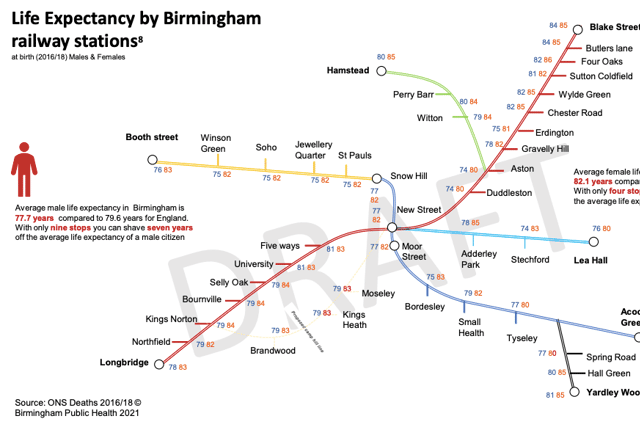“Investment is needed” - report reveals health inequality in Birmingham


A city councillor has said that more investment is needed for deprived areas of Birmingham after a report highlighted health inequalities across the city.
The Birmingham Health and Wellbeing Strategy document shows where illness rates are higher, with a ten-year difference in life expectancy between some wards of the city.
Advertisement
Hide AdAdvertisement
Hide AdStatistics
Life expectancy at birth for males in Heartlands is 71.8 years compared to 83.8 years in Sutton Four Oaks, with the average life expectancy at birth for females in Heartlands 76.9 years, compared to 86.4 years in Sutton Reddicap.
The document also shows that in Nechells, the rate of death from coronary heart disease is just over 2.5 times higher than the rate in Sutton Roughley, and that rates of childhood excess weight in reception class are 1.7 times higher in Kings Norton South than in Sutton Trinity, and in Year 6 the rates in Handsworth are 2.2 times higher than Sutton Trinity.
Councillor Shafique Shah, who represents Heartlands, said the difference in life expectancy in his ward is due to the ‘inequality of life chances’.
“In Heartlands, we have a higher percentage of disabled and sick people and people who have more than one health problem,” Cllr Shah told BirminghamWorld.
Advertisement
Hide AdAdvertisement
Hide Ad“People here are living on low incomes, and it is difficult for them to purchase healthy food as the higher income bracket residents in other areas can.
“Residents can’t afford expensive gym memberships, when they are facing difficulties feeding and clothing their children, and we have high crime and drug dependency rates here, and drug users living in the ward have numerous health problems and a shorter life span.
“Vehicles here are also older and more polluting than then in richer areas. We have high rates of asthma and COPD and the air pollution rates are higher and residents don’t have access to open green areas or the ability to travel out of the city to the fresh air of the countryside.”
A map produced by the city council in the document shows the life expectancy at different train and Metro stops in Birmingham.
Advertisement
Hide AdAdvertisement
Hide AdIt shows that in Stechford, the average life expectancy for men is 74 years and 83 years for women.


‘More investment is needed’
Councillor Baber Baz, who represents Yardley and the Stechford ward, said more investment is needed in areas where illness rates are higher.
“Stechford is a more deprived area and it’s a diverse ward as well so there needs to be more investment in these wards where there are issues,” he said.
“We need to be creating more open spaces and more activity so people can better their lives - at the moment there’s not many facilities around.
Advertisement
Hide AdAdvertisement
Hide Ad“Better parks and open space facilities will give people the opportunity to go out and improve their health.”


The national picture
Looking at how the city compares with the rest of the country; the average male life expectancy in Birmingham is 77.7 years and 79.6 years for England - and the average female life expectancy in Birmingham is 82.1 years compared to 83.2 years for England.
The infant mortality rate in Birmingham is 7.0 compared to 3.9 for England and 5.6 for the West Midlands (rate is a crude rate of deaths per 1,000 live births between 2017-2019).
The mortality rate in women for deaths under 75 years due to cardiovascular disease in Birmingham is 57.3 compared to 43.4 for England and 47.0 for the West Midlands (rate is measured in deaths/100,000 population between 2017-2019).
Advertisement
Hide AdAdvertisement
Hide AdPlans to create a healthier city
In the document, key actions are outlined to improve health across the city from 2022 to 2030, including focusing on creating an affordable healthy eating system, improving mental wellbeing, increasing physical activity among all ages, and developing the Clean Air Strategy.
Some of the actions include:
- Co-develop and implement a new Birmingham Food Strategy to create a healthier, affordable, safe and sustainable food system for the city.
- Work specifically on food justice and food security as a challenge in our most deprived communities, especially for children and families.
- Focused work on increasing healthy food literacy and deepen our understanding how to enable and empower this in different communities, especially across our ethnic communities
- Develop, enhance and implement evidence-based interventions to improve mental wellness and balance, including arts and culture-based interventions.
- Introduce technology including apps and gamification to increase inclusive physical activity participation for all including Birmingham’s diverse range of communities and underrepresented groups
- Ensure all partners are playing active roles as anchor organisations to support the Clean Air Strategy and Climate Change Route to Zero Strategy
A statement at the beginning of the report states: “Most health inequalities are driven by factors that sit outside the National Health Service. In essence by the time the health bit of the inequality reaches the NHS it is embedded and the challenge of rebalancing and mitigating the disease is significantly harder than if intervention had been earlier before the disease even appeared.
“Therefore, creating a bolder, healthier city focuses up-steam of disease, as well as reducing inequalities for those already living with chronic ill health, through focusing on shaping a healthier environment of opportunity for citizens to access affordable, sustainable, and enjoyable healthy lives that enables them to achieve potential and aspirations at every age.
“This strategy is the statutory Health and Wellbeing Strategy for Birmingham overseen through the statutory Health and Wellbeing Board. Working as a partnership across the City at citizen, community, city and regional levels, the Board and its partners will collaborate to create environments that enable healthier lives, employment and education approaches that support people to achieve their potential, and communities that support people together in positive and productive ways that improve their health and protect them from threats to their health and wellbeing.”
Comment Guidelines
National World encourages reader discussion on our stories. User feedback, insights and back-and-forth exchanges add a rich layer of context to reporting. Please review our Community Guidelines before commenting.
